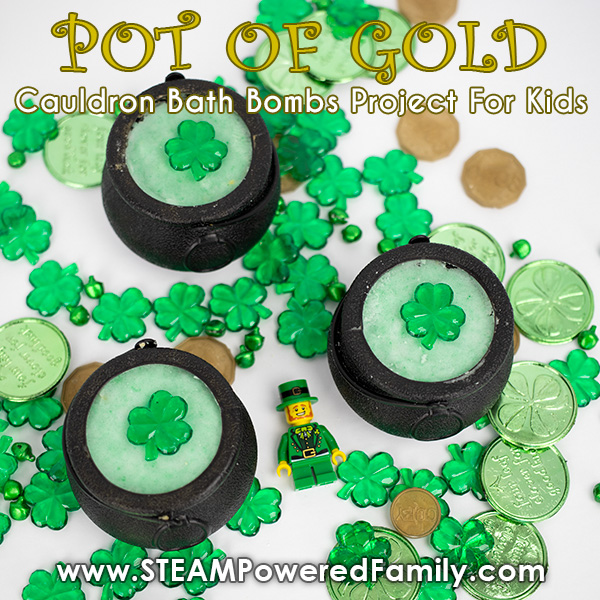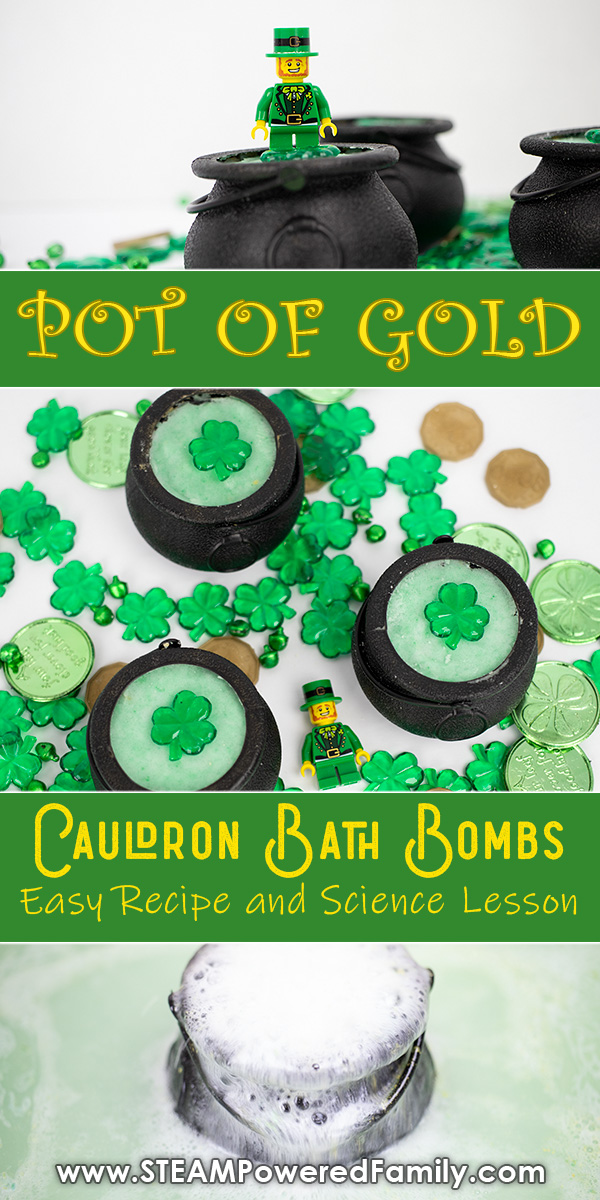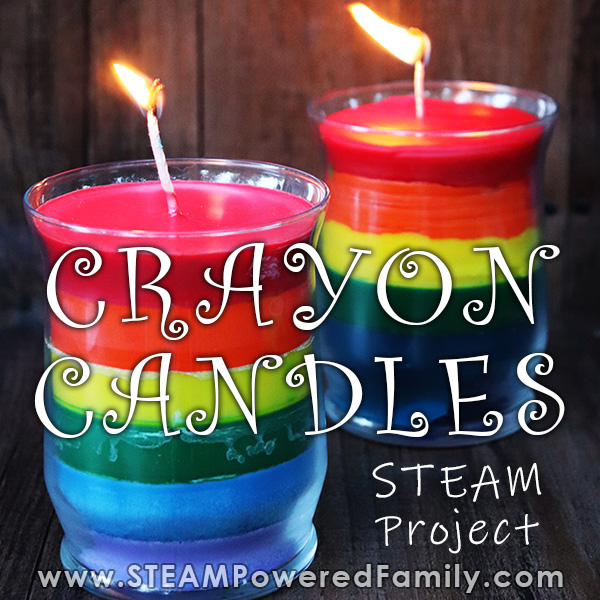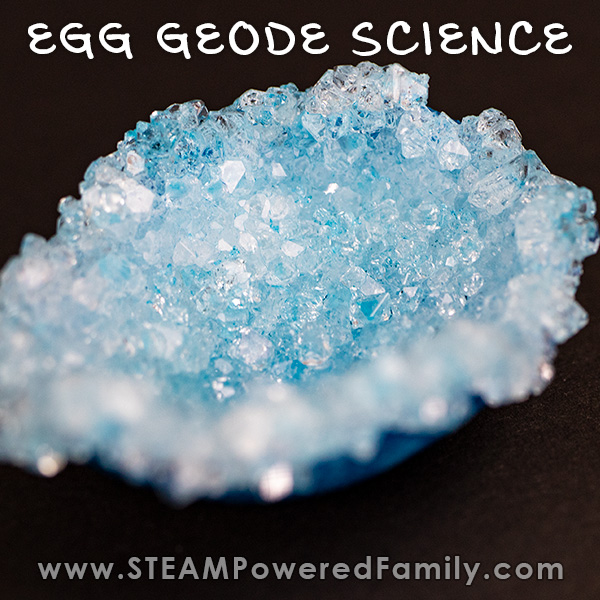Pot of Gold Cauldron Bath Bombs
Last fall we had a lot of fun making cauldron bath bombs that were Harry Potter House Reveal. Making bath bombs in the cauldrons is a great way for kids and first timers to make bath bombs because you don’t need to worry about the molds. Simply pack, let sit, and enjoy your bath! So for St. Patrick’s Day we decided it was time to pull out the cauldrons again and do a Pot of Gold Cauldron Bath Bomb project.
Pot of Gold Cauldron Bath Bombs for
St. Patrick’s Day

Disclaimer: This article may contain commission or affiliate links. As an Amazon Influencer I earn from qualifying purchases.
Not seeing our videos? Turn off any adblockers to ensure our video feed can be seen. Or visit our YouTube channel to see if the video has been uploaded there. We are slowly uploading our archives. Thanks!
It’s no secret we love making bath bombs. The kids enjoy the real life science and chemistry of the projects, and personally, I also really enjoy it. I like seeing my kids enjoying a project so much, plus it is saving me a lot of money keeping for my bath bomb loving kids.
Once you start making bath bombs you will realize it is a bit of an art, and a lot of science. With every batch we need to put on our critical thinking skills when things don’t work out quite right. Any bath bomb project that involves a removable mold has a risk of failure, often due to either too much moisture in the air, or too little.
That’s why the kids really enjoy these cauldron bath bombs. They are truly fool proof. Simply make your mix, pack your bath bombs, let them harden for a day and you are done!
This type of bath bomb making using cauldrons is especially perfect for classrooms, after school clubs and other groups. Since the kids can immediately, safely, transport their bath bombs home.
For another St. Patrick’s Day Bath Bomb, try these press style Shamrock bath bombs!

SUPPLIES FOR CAULDRON BATH BOMBS
- 1 cup corn starch
- 2 cups baking soda
- 1 cup citric acid
- 1/4 cup SLSA (Sodium Laurel Sulfoacetate)
- 4 tablespoons coconut oil
- 1 teaspoon polysorbate 80
- 20 drops Rosemary essential oil
- 20 drops Orange essential oil
- Mica powders (green and gold)
- 1 Large mixing bowl
- 2 smaller mixing bowls
- 1 microwave safe cup or bowl
- Plastic cauldrons
- St. Patrick’s Day Trinkets (four leaf clovers or gold coins) – optional
- Disposable gloves (optional but helps prevent staining your hands)

MAKING POT OF GOLD CAULDRON BATH BOMBS
Time needed: 1 hour
Here are the step by step directions for making cauldron bath bombs with a pot of gold surprise for St. Patrick’s Day!
- Mix dry ingredients
Start by mixing the dry ingredients, corn starch, baking soda, citric acid, and SLSA, in the large bowl. Be cautious pouring the citric acid, if it becomes airborne it can be very irritating to the eyes and nose.
- Mix wet ingredients
In a microwave safe container melt your coconut oil so it is liquid. Add the essential oils and polysorbate 80. Mix.
- Blend wet and dry
Next we add the wet ingredients to the large bowl and mix it in really well with the dry ingredients. You will want to use your hands and make sure you break down any clumps. Mix until it is the consistency of wet sand and can be formed and hold shapes.
- Adding Colour
Divide the mix into 2 smaller bowls. We decided we wanted more green with just a surprise gold layer inside. So we did 3/4 green, 1/4 gold. But you can divide your mix based on your preferences. Add a teaspoon of mica powder to the bowl and mix well. If desired add a bit more to get a darker colour, but be cautious, too much colour will result in a lot of colour in the bath which can get messy. Especially with kids who like to splash!
- Pack the Cauldrons
Start packing the mix into your cauldrons. Remember it will erupt from the top, so if you want to have the gold be a surprise inside, ensure you have a nice layer of green on top. Pack it well by pushing down firmly as you go. Feel free to add little trinket surprises as well if you wish! Just make sure you don’t do this with kids who put things in their mouth, and make sure it is too big to go accidentally down the drain.
- Let set
Allow the mixture to dry in the cauldron overnight.
- Storage
Make sure you store your bath bombs in an airtight container and keep all moisture out. Moisture in the air will cause it to erupt. One option is to wrap the cauldron in plastic until you are ready to use it.
- Using your Cauldron Bath Bomb
Simply fill your bath with warm water and drop in your cauldron for a fun, bubbly bath experience!
CAULDRON BATH BOMBS SCIENCE LESSON
The best part of making these bath bombs in cauldrons is how easy they are to make, and how much kids love learning about the science! Since we aren’t using molds, it takes some of the difficulty out of the project making it easier for younger kids or those that struggle with the molds. This means you can focus on the coolest part, the eruptions!
So what makes a bath bomb fizz? It is an acid-base reaction between the baking soda (our base) and citric acid (our acid). In the dry state they will not react, but once you add water the fizzing eruptions start as CO2 gas is released.
It doesn’t take much moisture to trigger the reaction, so you need to be careful of moisture in the air. If you try bath bomb making on a rainy day, you are likely to run into issues. You also don’t want to store your bath bombs in a bathroom that gets all steamy unless you take steps to protect it (like an air tight container).
Over time, even little bits of moisture will get through and your bath bomb will start to lose it’s fizz. It’s never been an issue, the kids are so excited to use their bath bombs, but I don’t recommend storing them for more than 3 months, as you will likely start to see noticeable declines in the intensity of the reaction.

The science of Polysorbate 80 and SLSA in bath bombs
Two other ingredients you can talk about that have a cool science role in our bath bombs, is the Polysorbate 80 and SLSA.
Polysorbate 80 is an emulsifier and is needed to make the oils mix with the bath water. Any child can tell you oil and water don’t mix, but if you add an emulsifier like polysorbate 80, they will mix, making for a wonderful bath. Without polysorbate 80 your bath bombs will create a floating layer of oils and colours, like a scum layer, that sticks to everything. So don’t forget the polysorbate 80!
Next is SLSA, Sodium Laurel Sulfoacetate, which is a surfactant. SLSA is not mandatory for bath bombs, but as a surfactant it helps create a luxurious bubble bath as your bath bomb erupts by capturing the CO2 into foamy bubbles! It also helps prolong the release of the essential oil fragrance.
I actually didn’t add SLSA to the cauldron bath bombs I made for this video (I ran out), it is definitely a desirable, but not necessary ingredient. As you can see the eruption happens normally, you just don’t get the bubble bath afterwards like we did in the video of our Easy Christmas Bath Bombs. So feel free to skip it if you need to!
















